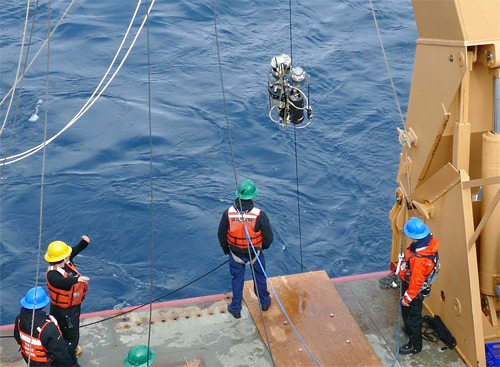Cruise Day 5
Speed 11.3 knots (kts)
Course 62° (ENE)
Depth 86 m
GO DEEPER DISCUSSION: (see previous journal for the questions.)
Short-tailed Albatrosses were extensively hunted for their feathers. In 1954 ornithologists found 25 breeding pairs on Tori-shima island, while 2364 breeding pairs were counted there and on Minami-kojima island in 2008. This is a nice upward trend but still very far from the estimated millions that were killed for their feathers.
TODAY’S JOURNAL:
We are on transit today to Station 2, were we expect to arrive around midnight. This will be a shelf station, meaning it will take place in shallow waters (~70 meters deep) of the continental shelf underlying the northeast Bering Sea. As you can see from our current depth, we have already sailed from the continental slope to the shelf since departing Station 1 early this morning. We are aiming for a point just a bit south of St. Lawerence Island in the north Bering Sea. As cruise time is precious, the team won’t wait until morning to get to work. Our station plan begins at midnight and runs through 11:30 tomorrow morning.
 Our position on the afternoon of August 13, heading for Station 2 south of St. Lawrence Island.
Our position on the afternoon of August 13, heading for Station 2 south of St. Lawrence Island.
I’ve already discussed the importance of using CTDs to recover samples from the water column for analysis back on board, but another key way to obtain water samples is by using pumps. This is an especially important technique when large volumes of water are needed. The largest Niskin bottles we have aboard have a 30 liter capacity. So if more water is needed for analysis it either requires using several Niskin bottles or pumping the large volume required into larger containers for later analysis. Pumps can also be used to move a high volume of water through filters that are designed to catch particles for later study.
On yesterday’s full station there were three pumping strategies employed. One team pumped water from just overboard up into 8 large holding tanks on deck.
 These 8 large sample tanks are used to store water that has been pumped up from the sea. Some analysis protocols require a very large volume of water to detect the minute amount of certain elements bing studies.
These 8 large sample tanks are used to store water that has been pumped up from the sea. Some analysis protocols require a very large volume of water to detect the minute amount of certain elements bing studies.
Another team headed out from the ship in a small boat in order to get their water samples far enough away from Healy to avoid contamination.
 One of the Healy’s two rigid-hull inflatable boats was used to get water samples away from the ship.
One of the Healy’s two rigid-hull inflatable boats was used to get water samples away from the ship.
A third team attached special battery-powered pumps to a cable that lowered them to their target depth from the aft A-frame crane. These didn’t collect water but instead pumped it through filters that were recovered once the pumps came back aboard and were detached from the winch cable.
 These pumps are used to push large volumes of water through filters at various depths by lowering them off the A-frame crane into the water column.
These pumps are used to push large volumes of water through filters at various depths by lowering them off the A-frame crane into the water column.
 Coast Guard crew members recovering a submersible sampling pump from the aft A-frame cable. Once aboard, researchers can collect the filters to analyze the samples they collected.
Coast Guard crew members recovering a submersible sampling pump from the aft A-frame cable. Once aboard, researchers can collect the filters to analyze the samples they collected.
.
GO DEEPER!
Station #2 is expected to last about half as long as Station #1 (which took ~24 hours to complete.) Can you think of a reason why we are expecting this station to go so much faster?
Aloft Con web cam updated every hour Healy Track
That's all for now. Best- Bill

